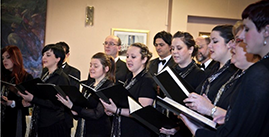Religious education
The aim of Christian parents and teachers, which they should always keep at least in the back of their minds, is: to inspire in the children personal love for Christ and for the Mother of God. If a child grows up honouring Christ and the Mother of God as beloved persons, this love will establish his heart in God, and even if he later goes through doubts, or even leaves the Church, at least he will not be against Christ in his heart; this may even be enough for his salvation.
The religious education of children is mainly brought about by example, and by the atmosphere of love and prayer in the home. The child's heart is touched; without explanations he acquires prayer as a natural activity, and without needing logical proofs he knows God's presence.
In the lives of saints, one sees often how a saint's destiny was influenced by someone holy whom he simply saw. St Nectarios always remembered his grandmother's love, and how she stood in prayer before icons.
Love, and prayer, and example, are more effective than words – indeed, it is these that give value to words – when leading children to God. Our work as parents or teachers of religion is often a hidden work, and it gives us experience of the "terrible" aspect of human freedom: that no one can impose love for God on another person. We would not wish otherwise; we wish to love God freely and we wish this for all mankind. Yet at the same time our prayer for our beloved children gives us continual inner pain. It is easier to speak than to pray.
When we are trying to teach children about God in words and we cannot find right expression or the subject changes, we should not necessarily force on our explanation – we must follow God's inspiration and the child's own mind. It is not so much by our words about God that we will help our children as by our dwelling in the presence of God. Christian adults tend to think God is not in a conversation if he is not the subject of conversation.
The best educational methods aim at teaching children how to learn. There is a proverb which says: Give your son a fish and he will eat well today. Teach him how to use a fishing-rod and he will eat well all his life". We understand our task as a Christian parents and teachers in a similar way. We inspire our children to love God and we teach them how to find the will of God for themselves. If our children taught to love God and the saints, "all the rest shall be added as surplus".
Icons are a good way for children to get to know and love Christ and the saints; even from a very young age a child can have icons of the Lord, or the Mother of God, of a saint, on his cot and on his room. Icons provoke children's questions, and also answer them. Icons should speak to all of us directly, visually - adults tend to verbalize and rationalize even their visual experience. Children often understand deep theological mysteries through icons – for example by comparing the icon of the Crucifixion with the icon of the Resurrection. They cannot always explain the mystery adequately, but their words and facial expression show that it has penetrated their heart and mind.
An icon is a very useful focus in a catechetical lesson; but it must always be treated respectfully, as an object of veneration, even when its pedagogical aspect is being emphasized.
From: "Children in the Orthodox Church today" by Sister Magdalen, Monastery of St. John, Essex, 2000.






